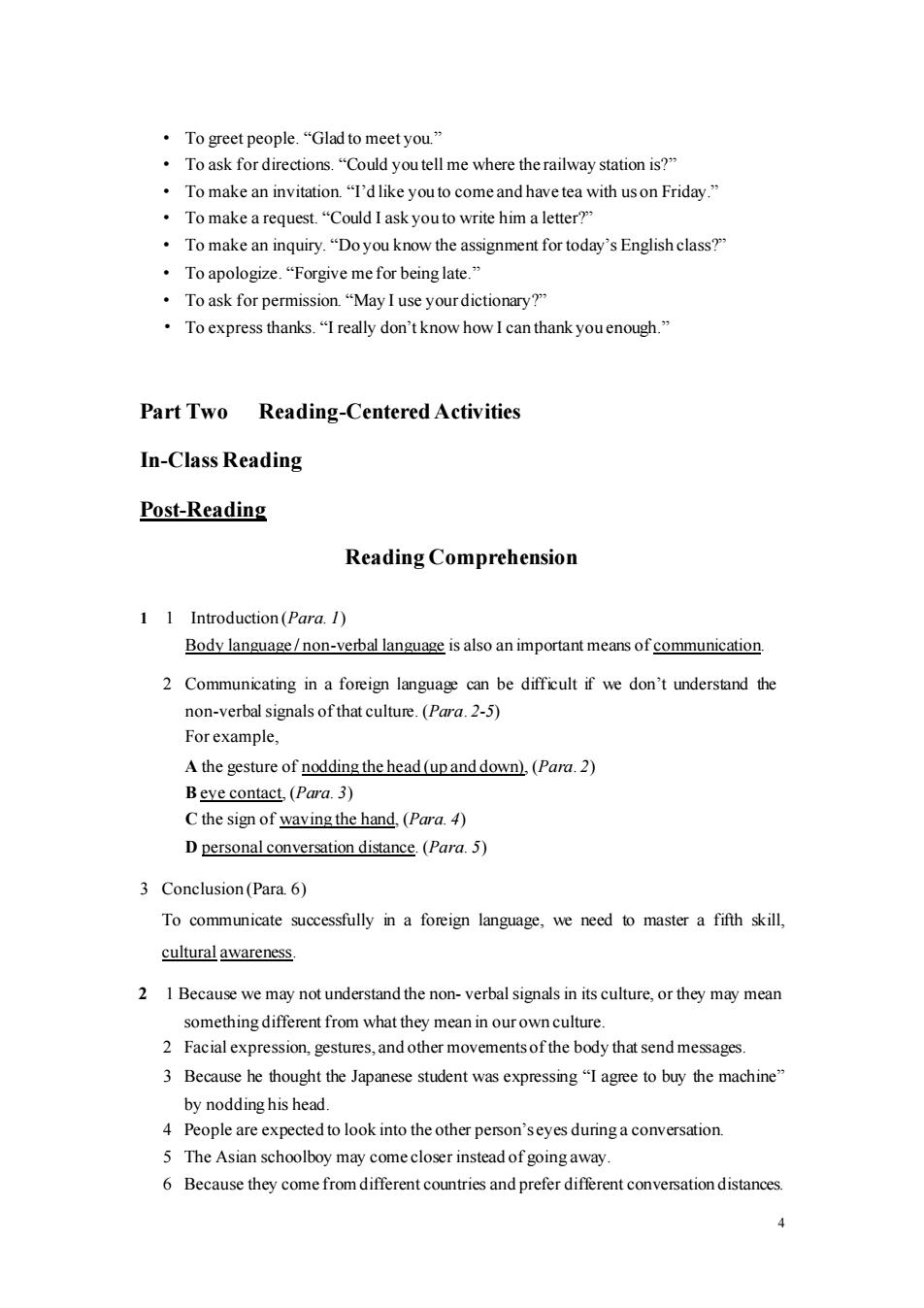正在加载图片...

·To greet people.“Glad to meet you.” To ask for directions."Could youtell me where the railway station is?" To make an invitation."I'd like you to come and have tea with us on Friday." To make a request."Could I ask you to write him a letter?" To make an inquiry."Do you know the assignment for today's English class?" ·To apologize.“Forgive me for being late.” To ask for permission."May I use your dictionary?" ·To express thanks.“I really don't know how I can thank you enough.” Part Two Reading-Centered Activities In-Class Reading Post-Reading Reading Comprehension 11 Introduction(Para.1) Body language/non-verbal language is also an important means of communication. 2 Communicating in a foreign language can be difficult if we don't understand the non-verbal signals of that culture.(Para.2-5) For example, A the gesture of nodding the head (up and down),(Para.2) Beye contact,(Para.3) C the sign of waving the hand,(Para.4) D personal conversation distance.(Para.5) 3 Conclusion(Para.6) To communicate successfully in a foreign language,we need to master a fifth skill, cultural awareness. 2 1 Because we may not understand the non-verbal signals in its culture,or they may mean something different from what they mean in our own culture. 2 Facial expression,gestures,and other movements of the body that send messages 3 Because he thought the Japanese student was expressing"I agree to buy the machine" by nodding his head. 4 People are expected to look into the other person'seyes during a conversation 5 The Asian schoolboy may come closer instead of going away 6 Because they come from different countries and prefer different conversation distances.4 • To greet people. “Glad to meet you.” • To ask for directions. “Could you tell me where the railway station is?” • To make an invitation. “I’d like you to come and have tea with us on Friday.” • To make a request. “Could I ask you to write him a letter?” • To make an inquiry. “Do you know the assignment for today’s English class?” • To apologize. “Forgive me for being late.” • To ask for permission. “May I use your dictionary?” • To express thanks. “I really don’t know how I can thank you enough.” Part Two Reading-Centered Activities In-Class Reading Post-Reading Reading Comprehension 1 1 Introduction (Para. 1) Body language / non-verbal language is also an important means of communication. 2 Communicating in a foreign language can be difficult if we don’t understand the non-verbal signals of that culture. (Para. 2-5) For example, A the gesture of nodding the head (up and down), (Para. 2) B eye contact, (Para. 3) C the sign of waving the hand, (Para. 4) D personal conversation distance. (Para. 5) 3 Conclusion (Para. 6) To communicate successfully in a foreign language, we need to master a fifth skill, cultural awareness. 2 1 Because we may not understand the non- verbal signals in its culture, or they may mean something different from what they mean in our own culture. 2 Facial expression, gestures, and other movements of the body that send messages. 3 Because he thought the Japanese student was expressing “I agree to buy the machine” by nodding his head. 4 People are expected to look into the other person’s eyes during a conversation. 5 The Asian schoolboy may come closer instead of going away. 6 Because they come from different countries and prefer different conversation distances